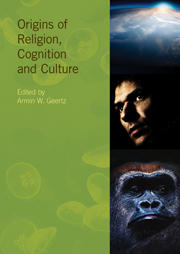Book contents
- Frontmatter
- Contents
- Contributors
- Introduction
- Part I EVOLUTIONARY SCENARIOS
- Part II COGNITIVE THEORIES
- 11 Cognition and meaning
- 12 Wittgenstein and the naturalness of religious belief
- 13 “Peekaboo!” and object permanence: on the play of concealment and appearance in cognition and religion
- 14 Yogācāra Buddhist views on the causal relation between language, cognition and the evolution of worlds
- 15 A resource model of religious cognition: motivation as a primary determinant for the complexity of supernatural agency representations
- 16 The recognition of religion: archaeological diagnosis and implicit theorizing
- 17 Religion and the extra-somatics of conceptual thought
- 18 Tools for thought: the ritual use of ordinary tools
- 19 Care of the soul: empathy in dualistic worldview
- 20 From corpse to concept: a cognitive theory on the ritualized treatment of dead bodies
- 21 Anthropomorphism in god concepts: the role of narrative
- Index
11 - Cognition and meaning
from Part II - COGNITIVE THEORIES
- Frontmatter
- Contents
- Contributors
- Introduction
- Part I EVOLUTIONARY SCENARIOS
- Part II COGNITIVE THEORIES
- 11 Cognition and meaning
- 12 Wittgenstein and the naturalness of religious belief
- 13 “Peekaboo!” and object permanence: on the play of concealment and appearance in cognition and religion
- 14 Yogācāra Buddhist views on the causal relation between language, cognition and the evolution of worlds
- 15 A resource model of religious cognition: motivation as a primary determinant for the complexity of supernatural agency representations
- 16 The recognition of religion: archaeological diagnosis and implicit theorizing
- 17 Religion and the extra-somatics of conceptual thought
- 18 Tools for thought: the ritual use of ordinary tools
- 19 Care of the soul: empathy in dualistic worldview
- 20 From corpse to concept: a cognitive theory on the ritualized treatment of dead bodies
- 21 Anthropomorphism in god concepts: the role of narrative
- Index
Summary
Introduction
There are two general views of religion shared by the greater part of the public in the modern world. The first is that, despite modernity, science, technology and so on, religion can be understood as something fundamentally human, social and meaningful although it may contain dubious claims to truths about the contents of the world. So conceived, religions are basically clusters of meaning, analogous to other forms of cultural expressions. The second view which is very prevalent in public discourse on the subject of religion is to think of religion along more psychological lines: “Religion and religiosity in particular, is a matter of feelings and conviction, a means of explaining existence or of orienting one's life.” Consequently, religion is understood either as “something” related to meaning on the one hand or as a psychological or mental phenomenon on the other (cf. e.g. Jensen 1999, 2004).
The following remarks are intended as a kind of road map to the difficulties of such trains of thought. The first problematic idea is that it is linguistically unacceptable to treat meaning as a mental phenomenon but that is not the sort of problem that disturbs the general public or violates popular epistemology. Linguists generally treat meaning as a non-mental phenomenon, and to understand this demands a certain degree of philosophical understanding, because “meaning is not in the head”, it is somewhere else.
- Type
- Chapter
- Information
- Origins of Religion, Cognition and Culture , pp. 241 - 257Publisher: Acumen PublishingPrint publication year: 2013



